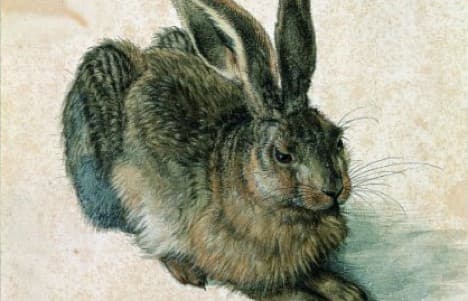Dürer's Easter favourite - hare to stay

Albrecht Dürer's Renaissance masterpiece the "Young Hare" is a ubiquitous favourite in Germany at Easter and was the model for the first chocolate bunnies. But what makes the furry fellow so fascinating, 500 years on?
The water-colour, painted in 1502 when the German master was 31 years old, is now considered one of the most reproduced drawings ever, adorning everything from paper serviettes to mouse pads.
The original is kept in the Albertina museum in Vienna, Austria. "It is certainly the most famous piece we have in the house," says the museum's Dürer expert and chief curator Maria Luise Sternath.
"Dürer's 'Praying Hands' used to have that honour, but over the last 20, 30 years, the hare has crystallized as the firm favourite."
But why do Germans love this big, long-eared hare so much? For a start, one glance shows that it is incredibly well rendered – the texture of its soft fur and the delicate bone structure beneath are almost tangible.
But experts say there is more to it than that – the picture reveals some of the essence of the creature. It's ears are pricked up, signalling that it is ready spring up and tear away. Sternath believes this gives the picture an "incredible fascination."
The picture also has a significant position in the history of art, mainly because the hare is the only focus. "Up until then, representations of animals were always packed into religious images," says Angela Wenzel, author of several books on art. "But now this hare comes along alone. This hare is just a hare."
That's one reason, the experts agree, why the painting still seems so modern – it could just as easily have been painted now.
Many scholars have wondered whether Dürer's painting is a portrait of a specific hare, and there is an apocryphal story that Dürer saved the animal from drowning in a flood, and took it to his studio in Nuremberg. Some have speculated that the window that can be seen reflected in the hare's eye is that of his studio.
The Young Hare's popularity today probably has a lot to do with the fame of its creator, but then again, there could be a simple explanation. "It's just soft. Soft and cuddly," says art historian Wenzel.
The Local/DPA/bk
Comments
See Also
The water-colour, painted in 1502 when the German master was 31 years old, is now considered one of the most reproduced drawings ever, adorning everything from paper serviettes to mouse pads.
The original is kept in the Albertina museum in Vienna, Austria. "It is certainly the most famous piece we have in the house," says the museum's Dürer expert and chief curator Maria Luise Sternath.
"Dürer's 'Praying Hands' used to have that honour, but over the last 20, 30 years, the hare has crystallized as the firm favourite."
But why do Germans love this big, long-eared hare so much? For a start, one glance shows that it is incredibly well rendered – the texture of its soft fur and the delicate bone structure beneath are almost tangible.
But experts say there is more to it than that – the picture reveals some of the essence of the creature. It's ears are pricked up, signalling that it is ready spring up and tear away. Sternath believes this gives the picture an "incredible fascination."
The picture also has a significant position in the history of art, mainly because the hare is the only focus. "Up until then, representations of animals were always packed into religious images," says Angela Wenzel, author of several books on art. "But now this hare comes along alone. This hare is just a hare."
That's one reason, the experts agree, why the painting still seems so modern – it could just as easily have been painted now.
Many scholars have wondered whether Dürer's painting is a portrait of a specific hare, and there is an apocryphal story that Dürer saved the animal from drowning in a flood, and took it to his studio in Nuremberg. Some have speculated that the window that can be seen reflected in the hare's eye is that of his studio.
The Young Hare's popularity today probably has a lot to do with the fame of its creator, but then again, there could be a simple explanation. "It's just soft. Soft and cuddly," says art historian Wenzel.
The Local/DPA/bk
Join the conversation in our comments section below. Share your own views and experience and if you have a question or suggestion for our journalists then email us at [email protected].
Please keep comments civil, constructive and on topic – and make sure to read our terms of use before getting involved.
Please log in here to leave a comment.